We are Texas Barndominium Specialists
Style and Installation Options for Barndominiums
Barndominium Exteriors Available in Three Basic Styles
Sierra Style
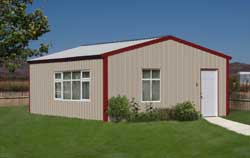
- A classic home kit design.
- Vertically-oriented exterior wall and roof panels.
- Distinctive design.
- Superior runoff for rain and snow.
Mohave Style
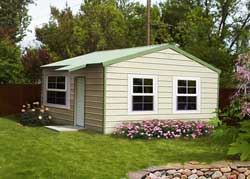
- Best suited for areas with deep winter snows.
- Steep roof lines shed snow easily.
- This style is suggested if you are building in the high country, or heavy-snow regions.
- Extra storage space up above the living areas on some floor plans.
Gambrel Style

- Featuring the traditional Gambrel style signature roof design.
- The Gambrel design, also called Dutch hip or Dutch gambrel – makes for an ideal cabin.
- The steeply sloping roof sheds snow with ease.
- The extra space gained by the steep roof makes for a great loft or storage area.
Easily Complete Your Barndominium
Your home kit includes:
- The steel frame. Your kit is shipped in a manageable bundle that can fit on a small trailer, or in the bed of a larger pick up truck.
- Exterior walls.
- Complete roof
- Simple and complete instructions.
Easy to Assemble
Your kit home’s finished shell can be put together by as few as two people, with little or no prior construction experience and using common tools! This means YOU can do it, whether you build yourself or act as an owner/builder using local tradesmen and contractors.
Frame System Details
About the Steel Frame System
At the heart of Absolute Steel’s barndominium kits is our internationally-known steel frame system.

Quality Steel and American Ingenuity
All steel used in Absolute Steel kit homes and guest house kits must meet certain engineering specifications for alloy content, strength and durability. Rest assured that the steel we use comes from reputable companies. We also insist upon Material Test Sheets that verify the purity of the metal for our steel frame houses.
You may be able to find steel at lower prices, sourced from unreliable vendors, but with such metal you have no solid guarantee of what you’re really getting.
Our standard steel building main frames are comprised of 2″x 3″ and 2″ x 4″ tubular steel. This is 14 or 15 gauge steel, depending on the load a particular piece may have to bear.
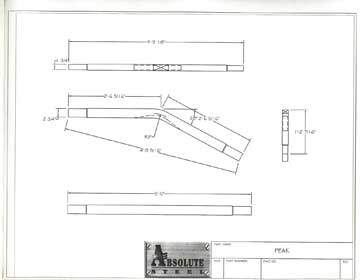

As an example, the steel in our roof peaks is rated at a yield strength of 65,000 ksi. That means the steel will withstand a pressure of more than 130,000 pounds per square inch before yielding. That’s the lowest rating we’ll accept. It can be a bit more expensive to do that at times, but we are talking about people’s lives and property.
Corrosion Resistance
To prevent rust and corrosion, our steel is given a galvanized (electronically bonded) protective coating. And, as a final safeguard, it receives a tough clear resin coating. In fact, our steel frames are so corrosion resistant that they’ve been chosen by every branch of the US armed forces, and you’ll even find them deep within the Ohio salt mines of Cargill Salt.
Home Kit Foundations: Built Strong
You know that a building’s base is one of its most critical components. The strength and security of the entire structure rests on that base – literally.
Absolute Steel uses a unique insert system in all base rail components for its kit homes and guest houses. This makes it an easier system to erect—using our insert system, two people can assemble walls and roof frames with ease.
Another important difference is our system for connecting base sections, used to achieve a building’s desired length. Other manufacturers crush, roll or bend portions of their base rails, so pieces can be slipped together. The process can significantly thin, stress and even fracture the steel at a critical point.
Rather than do anything that would compromise frame strength, we use a system of 14 gauge steel inserts to connect base rail sections. This means a small added step or two in our fabrication process, but it safeguards the integrity of the steel – and the strength of your home
Here are a couple of the less obvious benefits:
- At the base of your building, where water or condensation can collect, you have thick, unstressed and uniform connections. This ensures the prevention of rust and corrosion to form where it would do the most damage.
- You’ll always have a consistent fit. Never a need for a sledgehammer to pound parts together, just because someone’s bending machinery was out of adjustment.
Home Kit Sidewalls: Easier Assembly, Greater Strength
Moving up from the base rails, our frame system offers yet another advantage. Similar to the base rails, most manufacturers crush, bend or roll components to connect base rails and sidewalls.
At Absolute Steel, rather than damaging the metal, we once again use an insert system to form solid connections. This even makes it easier to make small adjustments in sidewall height, with no loss of strength or stability.

The Worst Connection
Steel Frame Crushed Connection
(the weakest)

A Better Connection
Steel Frame Rolled Connection
(better, but not the best)

The BEST Connection (Ours)
Cabin kit slip-joint connection
(the strongest connection)
DIY Assembly
DIY Barndominium Assembly
This is the same steel building system we’ve manufactured and sold for years—it goes together as easily as you can slip two pieces of steel together. We call it Slip Joint Connections.
Slip-Joint Connections make assembly easy. Always a smoother, stronger connection.

If you’ve been wondering how to build your own barndominium, here is your answer. A do-it-yourself dream. Even if you don’t plan on doing it yourself, you still win – your contractor will be able to complete the job fast.
Your barndominium shell package includes illustrated, step-by-step instructions – easy to follow and calling for only a few basic tools.
Save Money – Be an Owner/Builder
Even a dedicated do-it-yourselfer may not think it’s wise to tackle some of the specialized jobs involved in putting up a complete home or guest house. Maybe you’re not quite comfortable with electrical work, or up to date on current plumbing regulations. Or maybe you just plain don’t like to work with drywall. There’s a simple answer for cases like that: There’s a simple answer for cases like that: an owner / builder.
As owner/builder, you do some of the work yourself, and hire contractors to do other parts of the job. It amounts to acting as your own general contractor, and for many people, it’s the perfect way to go.
If you need help deciding which way to go, call one of our kit homes representatives at (888) 658-5147 and ask them to send you a complete set of installation instructions.
Below is an example of how our structures go together…
Step 1
Assemble and install base rails.
Step 2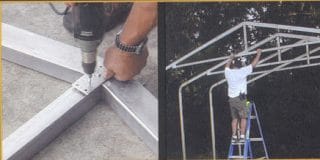
Assemble and position roof/wall frames.
Step 3
Attach purlins and girts.
Step 4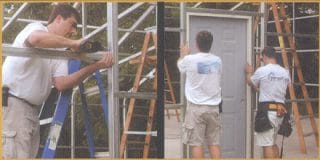
Install door and window framing.
Step 5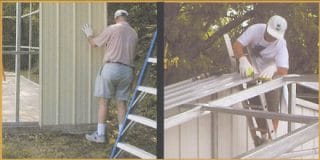
Attach side panels and metal roofing.
Step 6
Install trim and doors. Enjoy your new building.
Contractor Assembly
Selecting a Contractor
If you are opting to use a contractor to build your barndominium, then choosing a good contractor is one of your most important steps as an owner. If you’ve decided the do-it-yourself route isn’t for you, here are some guidelines to selecting someone who will do a professional job at a fair price.
- The contractor reality check
- Estimates and the lowest bidders
- Interviews
- Checking references
- Getting a written contract
- Completing the job – a checklist
- Feedback
“Reality Check”
Your most important job in contractor selection amounts to a “reality check” into any contractor you’re considering. There are a few fairly simple ways to go about this.
First, you can check into the contractor’s past jobs. Go have a look in person, or call the owners or residents.
These days it’s pretty easy to go to your local licensing agency (usually a state agency) to find out if there are any outstanding or unresolved complaints filed against a contractor.
Consulting the Better Business Bureau (http://www.bbb.org/) is also a good practice. Here you can find out whether a contractor has been accredited by the BBB, and learn about the company’s reputation with past clients.
In many areas there are also websites that offer ratings and reviews of local businesses. These can be found by searching for “business reviews _(your city or area)_” using Google, Yahoo or other search sites.
Estimates and the Lowest Bidders
It’s smart to get written estimates from several different contractors before settling on one to build your building kit.
Automatically hiring the lowest bidder isn’t always the best bet. Instead, compare estimates closely. Ask low bidders why their bids are different from others. They may very well be offering you a great value – but they may have omitted parts of the job, mistakenly or otherwise. Some contractors have been known to do this, only to bring them up later as expensive “add-ons,” once the job is under way.
Interviews
Meeting with and interviewing any contractor you’re seriously considering is another excellent idea. Here are some important questions to ask.
- How long have you been in business?
- Are you licensed and registered with the state?
While most states license electrical and plumbing contractors, only 36 states have some type of licensing and registration statutes affecting contractors, remodelers, and/or specialty contractors. The licensing can range from simple registration to a detailed qualification process.
Also, the licensing requirements in one locality may be different from the requirements in the rest of the state. Check with your local building department about licensing requirements in your area. If your state has licensing laws, ask to see the contractor’s license. Make sure it’s current.
- How many projects like mine have you completed in the last year?
Ask for a list. This will help you determine how familiar the contractor is with your type of project.
- May I have a list of references?
The contractor should be able to give you the names, addresses, and phone numbers of at least three clients whose projects were similar to yours. Ask each how long ago the project was completed, and if you can see it.
- What types of insurance do you carry?
Contractors should have personal liability, worker’s compensation, and property damage coverage. Ask for copies of insurance certificates, and make sure they’re current. Avoid doing business with contractors who don’t carry the appropriate insurance. Otherwise, you’ll be held liable for any injuries and damages that occur during the project.
Checking References
Talk with some of the contractor’s former customers. They can help you decide if a particular contractor is right for you. You may want to ask:
- Can I visit your home to see the completed job?
- Were you satisfied with the project? Was it completed on time?
- Did the contractor keep you informed about the status of the project, and any problems along the way?
- Were there unexpected costs? If so, what were they?
- How did the contractor handle any problems that came up?
- Did workers show up on time? Did they clean up after finishing the job?
- Would you recommend the contractor?
- Would you use the contractor again?
Getting a Written Contract
Contract requirements vary by state. Even if your state does not require a written agreement, ask for one. A contract spells out the who, what, where, when and cost of your project. The agreement should be clear, concise and complete. Before you sign a contract, make sure it contains:
- The contractor’s name, address, phone, and license number, if required.
- The payment schedule for the contractor.
- An estimated start and completion date.
- A detailed list of all materials including color, model, size, brand name, and product that you will be turning over to the contractor, for use on the job.
- Warranties covering materials and workmanship. The names and addresses of the parties honoring the warranties — contractor, distributor or manufacturer — must be identified. The length of the warranty period and any limitations should also be spelled out.
- What the contractor will and will not do. For example, is site clean-up and trash hauling included in the price? Ask for a “broom clause.” It makes the contractor responsible for all clean-up work, including spills and stains.
- Oral promises also should be added to the written contract.
Completing the Job: A Checklist
Before you sign off and make the final payment, use this checklist to make sure the job is complete.
Check personally to verify:
- All work meets the standards spelled out in the contract.
- The job site has been cleaned up and cleared of excess materials, tools and equipment.
- You have inspected and approved the completed work—sometimes done in phases.
- Any inspections by local building inspectors have been completed and passed. This may mean more than one inspection, by two or more different inspectors. For example, in some areas there are different inspectors and inspections for a building’s foundation, its plumbing, its electrical work, structural work, etc.
Feedback – What You Have to Say is Valuable
Once your new house is complete, you can be a big help to others who are hunting for a contractor. Go back to the Better Business Bureau’s site and leave a review of your experience. Do the same with other ratings-and-reviews-sites. Whether your review is positive, negative, or mixed, what you have to say is sure to help someone else find the right contractor. If your contractor has done a great job, your review could also help send more business his way – probably the best bonus you could give.
Barndominium Info:
Questions?
Contact
9476 County Road 136
Terrell, Texas 75161
Local Phone: (972) 524-1099
Fax: (972) 524 1402
Absolute Steel Barndominiums are highly engineered, yet easy to install.

